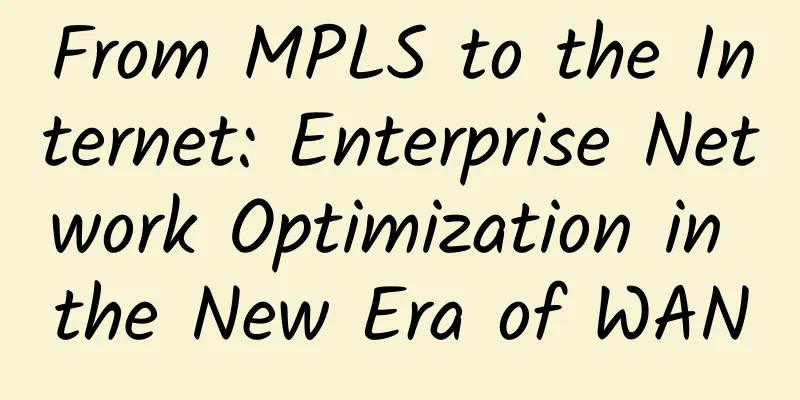From MPLS to the Internet: Enterprise Network Optimization in the New Era of WAN

|
There is no doubt that WANs look different than they did a decade ago. Today, many large enterprise WANs include multiple underlying technologies from multiple vendors, including Infrastructure as a Service (IaaS), Software as a Service (SaaS), and Unified Communications as a Service (UCaaS). In my opinion, there are four major forces influencing the evolution of WAN from MPLS to the Internet.
Data centers are movingIn recent years, enterprises' data centers have been migrating. In 2019, TeleGeography surveyed 64 large multinational companies and found that while about one in ten companies still keep all of their data centers on-site, nearly one in five have moved away from their local area. Most enterprises have a hybrid configuration of on-premises and in the cloud. But as a result, most enterprise IT infrastructure teams are seeing a shift in traffic patterns away from hubs connected to MPLS-based intranets. Cloud delivery modelMost enterprises are now multi-cloud, too. Nearly three-quarters of WAN survey respondents have two or more IaaS partners. Additionally, these enterprises are using multiple methods to connect to their IaaS providers. Two out of five enterprises are primarily Internet connected. This is outpacing the explosive growth of SaaS/UCaaS offerings in the enterprise. It doesn’t make sense to push all this Internet-native traffic to central breakouts over expensive MPLS circuits. So even before enterprises started adopting software-defined wide-area networks (SD-WAN), there was pressure to move traffic to local Internet breakouts. SD-WAN adoptionIn 2018, less than one in five enterprises had adopted SD-WAN. By 2020, that proportion had doubled to more than two-fifths. A quarter of respondents were in the pilot or rollout phase. Why are these companies adopting SD-WAN? The two main reasons are the need to increase site capacity and to select alternative products for the ground floor. Lower Internet costsUndoubtedly, the price difference between MPLS and Internet alternatives also contributes to the desire of enterprises to increase capacity and use alternative products. Survey data shows that the port size of MPLS is smaller than that of Internet. Its enterprise service pricing research also shows that there is still a gap between DIA and MPLS port pricing, not to mention that DIA generally does not require additional access line charges while MPLS does not. What should WAN managers do in the post-MPLS era?All this points to a clear trend that enterprises are relying less on MPLS and more on the Internet. In 2018, 82% of WAN Manager Survey respondents had sites running MPLS. By 2020, that number dropped to 58%. DIA and broadband have also gained ground in the same period. These factors have pushed companies’ WANs from MPLS to the Internet. But what impact does this have on WAN managers and their vendors? First, WAN managers must consider the geographic footprint of their cloud service providers (CSPs), not just their own data center sites. It is very important to keep a close eye on the CSP's footprint expansion. Enterprises must also choose data center locations from among thousands of sites operated by hundreds of different providers. Data centers vary not only in the cost of power, cross-connects, and rack space, but also in CSP access, network provider presence, and ability to reach a switching office or fabric provider. This brings me to my final new concern. WAN managers must evaluate what happens to their traffic after it leaves the office over the most efficient Internet connection. Performance in the "internet middle," once a telco issue on MPLS networks, is now a concern for enterprises. Whether choosing a Tier 1 Internet Service Provider (ISP), using a Network as a Service (NaaS) provider, an OTT mid-path optimization tool, or joining a peering exchange, WAN managers now have a whole new set of vendors or solutions to evaluate to ensure end-to-end performance. The key now is how WAN vendors – whether telcos, system integrators (SIs), managed service providers (MSPs), or novel solutions – can address and process these changes together with multinational enterprises. |
<<: Five disruptive features of 6G networks
>>: Telecom APIs: A critical IT tool for expanding services and improving customer experience
Recommend
Implementing a simple TCP custom protocol based on Kotlin
1. Development Background If you want to be an ex...
edgeNAT is now available on Los Angeles Unicom CUVIP line host, with a 60% discount and monthly payment starting at 30 yuan
Recently, there are quite a lot of merchants who ...
XenSpec: Chicago/San Jose 1Gbps Unlimited VPS Starting at $2.95/month
XenSpec is a foreign hosting company registered s...
CommScope’s Viewpoint: Operators’ Network Efficiency Transformation in the 5G Era
Despite the impact of the "black swan" ...
Review of 5G in 2019: 5G sounded the rally call for commercial use
"5G is like a newborn baby, new from head to...
Starlink Internet service users exceed 10,000
SpaceX's satellite internet service has been ...
How should building owners prepare for 5G?
[[347744]] Few technologies have been in the spot...
Why do we need UDP protocol?
Every programmer should know TCP and UDP protocol...
Where will the evolution of SD-WAN go?
Since the advent of SD-WAN technology five years ...
[Black Friday] Sharktech: 50% off on all cloud products, 10Gbps unlimited traffic server $349/month-2*Gold 6148/128G/2TB NVMe/Los Angeles and other data centers
Sharktech also released a promotion during this y...
An overlooked "secret weapon" in the 5G era may break the market monopoly
Recently, the Ministry of Industry and Informatio...
Blockchain subverts the underlying architecture of the financial industry and opens a new era of value interconnection
Blockchain is essentially a decentralized databas...
Huawei and its global partners work together to build a full-scenario smart life
【51CTO.com original article】 Normal 0 7.8 磅 0 2 f...
UUUVPS newly launched Los Angeles AS9929 line VPS with 15% discount, native IP monthly payment starts from 33 yuan
UUUVPS (Sanyou Cloud) has newly launched the AS99...
Foreign media: South Korea's 2G network services will be terminated in June and operators will fully switch to 5G
According to foreign media reports, South Korea&#...




![[11.11] Hostons: AMD Ryzen+NVMe series VPS 50% off starting at $2/month, multiple data centers in Los Angeles/Salt Lake City/Portland, etc.](/upload/images/67cabd0fb889e.webp)




